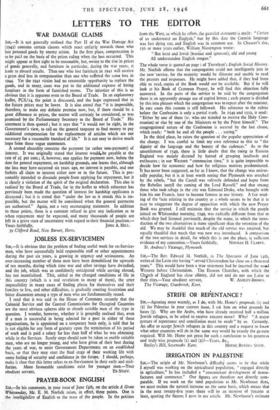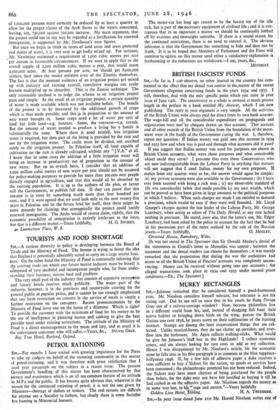IRRIGATION IN PALESTINE
Sut,—The origin of Mr. Newhouse's difficulty seems w be that while I myself was working on the agricultural population, " engaged directly in agriculture," he has included a " concomitant development of manu- factures and commerce." Our figures are therefore not directly com- parable. If we work on the total population as Mr. Newhouse does, we must reckon the natural increase on the same basis, which means that in the next twenty-five years there will be an increase of 700,000 at least, quoting the figures I gave in my article. Mr. Newhouse's estimate
of 1,000,000 persons must certainly be reduced by at least a quarter to allow for the proper claims of the Arab States to the waters concerned, leaving, say, 750,000 against 700,000 increase. My main argument, that the project could not in any way be regarded as a justification for renewed immigration, is supported by Mr. Newfiouse's own figures.
But once we begin to think in terms of land areas and areas protected and duties of water, it is very easy to act badly mixed up. For instance, Mr. Newhouse estimated a requirement of r,000 cubic metres per acre - per annum in favourable circumstances. If we were to apply this to the overall supply of 2,000 million cubic metres a year, that would mean 2,000,000 acres. At four persons per acre, we should get 8,000,000 settlers, four times the rosiest estimate even of the Zionists themselves. The fact is that the moment estimates of an irrigation project get mixed up with industry and existing rainfall, cumulative margins can easily become multiplied up to absurdity. That is the Zionist technique. The only reasonable method is to judge the scheme as an irrigation project pure and simple. As the result of an irrigation project, a certain quantity of water is made available which was not available before. The benefit of the project is to be measured by the additional growth of crops which is thus made possible, and this,is in proportion to the amount of new water brought in. Some crops need a lot of water per unit of land but little land—e.g. bananas. Some, the converse—e.g. cereals. But the amount of water needed to produce a living for a family is substantially the same. Where there is good rainfall, less irrigation water is required, but then part of the living is provided by the rain and not by the irrigation water. The credit must be divided, not ascribed solely to the irrigation project. In Palestine itself, all land capable of cultivation on the rain is already cultivated, without any " J.V.A." at all. I know that in some cases the addition of a little irrigation water will bring an increase in productivity out of proportion to the amount of new water. But on an overall basis, I consider that an addition of 2,000 million cubic metres of new water per year should not be assumed for policy-making purposes to provide for more than 200,000 new people directly engaged in agriculture, and that this would all be absorbed by the existing population. It is up to the authors of the plan, or better still the Government, to publish full data. If they can prove that this 200,000 is in error by something much more than four hundred per cent., and if it were agreed that we need look only to the next twenty-five years in Palestine and let the future fend for itself, then there might be some grounds for claiming that econmically the project could justify renewed immigration. The Arabs would' of course claim, rightly, that the economic possibility of immigration is entirely irrelevant to the issue, but that is a different matter.—Yours faithfully, M. G. IONIDES. 4a Launceston Place, W. 8.































 Previous page
Previous page